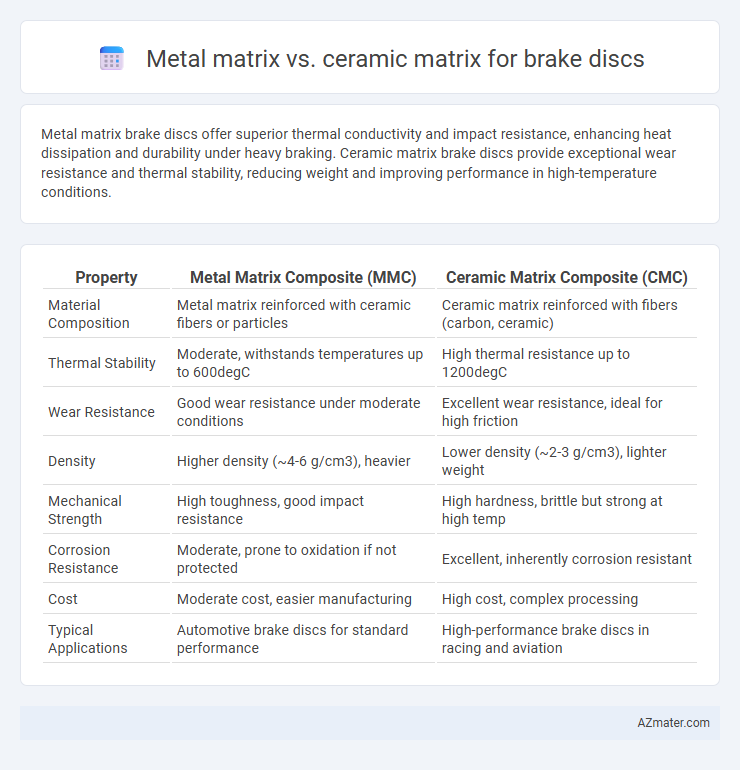Metal matrix brake discs offer superior thermal conductivity and impact resistance, enhancing heat dissipation and durability under heavy braking. Ceramic matrix brake discs provide exceptional wear resistance and thermal stability, reducing weight and improving performance in high-temperature conditions.
Table of Comparison
| Property | Metal Matrix Composite (MMC) | Ceramic Matrix Composite (CMC) |
|---|---|---|
| Material Composition | Metal matrix reinforced with ceramic fibers or particles | Ceramic matrix reinforced with fibers (carbon, ceramic) |
| Thermal Stability | Moderate, withstands temperatures up to 600degC | High thermal resistance up to 1200degC |
| Wear Resistance | Good wear resistance under moderate conditions | Excellent wear resistance, ideal for high friction |
| Density | Higher density (~4-6 g/cm3), heavier | Lower density (~2-3 g/cm3), lighter weight |
| Mechanical Strength | High toughness, good impact resistance | High hardness, brittle but strong at high temp |
| Corrosion Resistance | Moderate, prone to oxidation if not protected | Excellent, inherently corrosion resistant |
| Cost | Moderate cost, easier manufacturing | High cost, complex processing |
| Typical Applications | Automotive brake discs for standard performance | High-performance brake discs in racing and aviation |
Introduction to Brake Disc Materials
Brake discs require materials with high thermal conductivity, wear resistance, and mechanical strength to withstand extreme braking conditions. Metal matrix composites (MMCs), often aluminum or iron-based, provide superior thermal dissipation and toughness, making them ideal for heavy-duty and high-performance applications. Ceramic matrix composites (CMCs), primarily silicon carbide or carbon fiber reinforced, offer exceptional hardness, low density, and resistance to thermal fatigue, resulting in improved braking performance and longevity under high-temperature environments.
Overview of Metal Matrix Composites
Metal Matrix Composites (MMCs) used in brake discs offer enhanced thermal conductivity, superior wear resistance, and improved strength-to-weight ratios compared to traditional materials. MMCs typically incorporate aluminum or magnesium matrices reinforced with ceramic particles such as silicon carbide, resulting in better heat dissipation and reduced brake fade under high-stress conditions. These composites provide a robust solution for high-performance braking systems, balancing durability with lightweight construction for improved vehicle handling.
Overview of Ceramic Matrix Composites
Ceramic matrix composites (CMCs) in brake discs offer superior high-temperature resistance and reduced weight compared to traditional metal matrix composites (MMCs), enhancing thermal stability and wear resistance under extreme conditions. CMCs, composed primarily of ceramic fibers embedded in a ceramic matrix, exhibit low thermal expansion and excellent oxidation resistance, making them ideal for high-performance braking systems in aerospace and motorsports. The advanced microstructure of CMCs enables improved braking efficiency, longer service life, and reduced maintenance compared to metal-based brake discs.
Key Performance Criteria for Brake Discs
Metal matrix composites (MMC) brake discs excel in thermal conductivity and toughness, enabling rapid heat dissipation and resistance to impact, which reduces brake fade during intense braking. Ceramic matrix composites (CMC) offer superior hardness, wear resistance, and high-temperature stability, significantly enhancing disc durability and maintaining consistent friction coefficients under extreme conditions. Both materials demonstrate distinct advantages in thermal management, mechanical strength, and longevity, with MMCs favored for their impact resilience and CMCs preferred for high-performance applications requiring minimal wear and weight savings.
Thermal Conductivity: Metal vs Ceramic Matrices
Metal matrix composites used in brake discs exhibit higher thermal conductivity, often ranging between 100 to 200 W/m*K, which facilitates efficient heat dissipation during braking. Ceramic matrix composites, with thermal conductivity values typically below 30 W/m*K, provide superior thermal resistance but slower heat transfer, reducing the risk of thermal degradation under extreme conditions. Optimizing brake disc performance requires balancing the metal matrix's rapid heat dispersion with the ceramic matrix's heat tolerance to prevent thermal cracking and ensure consistent braking efficiency.
Wear Resistance and Longevity Comparison
Metal matrix composites (MMCs) for brake discs offer enhanced toughness and thermal conductivity, leading to reliable wear resistance under high-stress conditions. Ceramic matrix composites (CMCs) provide superior hardness and reduced wear rates, resulting in significantly longer service life and improved resistance to thermal degradation. While MMCs balance cost and durability, CMCs deliver exceptional longevity and consistent performance in high-temperature environments.
Weight and Rotational Inertia: Impacts on Vehicle Dynamics
Metal matrix brake discs generally exhibit higher weight compared to ceramic matrix counterparts, directly influencing the vehicle's unsprung mass. The increased mass of metal matrix discs elevates rotational inertia, which can reduce acceleration responsiveness and braking efficiency. Ceramic matrix composites offer lower density, reducing rotational inertia and enhancing vehicle dynamics through quicker response and improved handling.
Cost and Manufacturing Considerations
Metal matrix brake discs typically offer lower manufacturing costs due to established production techniques like casting and machining, making them cost-effective for mass production. Ceramic matrix composites involve complex fabrication processes such as chemical vapor infiltration, resulting in higher material and processing expenses. The cost-efficiency of metal matrix discs contrasts with the superior wear resistance and thermal stability of ceramic matrix discs, which demand advanced manufacturing infrastructure and longer production times.
Application Suitability: Automotive and Motorsport Use
Metal matrix composites (MMCs) offer superior thermal conductivity and impact resistance, making them highly suitable for automotive brake discs requiring durability under high-stress conditions. Ceramic matrix composites (CMCs) provide exceptional heat tolerance and lighter weight, preferred in motorsport for enhanced performance and reduced unsprung mass. MMCs excel in everyday automotive applications with cost-effective durability, while CMCs dominate racing environments demanding maximum thermal stability and weight savings.
Future Trends in Brake Disc Material Technology
Metal matrix composites (MMCs) and ceramic matrix composites (CMCs) represent the forefront of brake disc material technology, with MMCs offering superior thermal conductivity and impact resistance essential for high-performance braking systems. Future trends emphasize the development of hybrid composites that combine metal and ceramic matrices to optimize heat dissipation, wear resistance, and weight reduction. Advances in nano-reinforcements and additive manufacturing are expected to enhance the mechanical properties and customization capabilities of brake discs, driving innovation toward more efficient and durable braking solutions.

Infographic: Metal matrix vs Ceramic matrix for Brake disc
 azmater.com
azmater.com